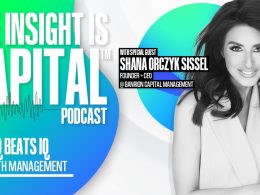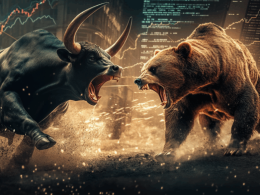Everyone’s buzzing about GPUs, ChatGPT, and the AI arms race—but Morgan Stanley’s Counterpoint Global team is urging investors to take a step back. Their April 2025 research, AI Beneficiaries: Investing in Second-Order Effects1, flips the script: the best AI plays, they argue, won’t necessarily be the companies building the tech—but the ones quietly using it to supercharge productivity, cut costs, and widen margins.
Their big idea?
“The best investments were often not the obvious, first-order ones but rather the second-order ones.”
In other words: don’t just chase the shiny objects. Look for the players embedding AI into the boring, back-office stuff—where it quietly transforms how business gets done.
From GPUs to Grill Lines: The Second-Order Sweet Spot
History’s full of game-changing tech stories... that didn’t deliver game-changing returns for the people who bet on them. Think U.S. carmakers in the 1920s or Wi-Fi router manufacturers in the early 2000s. The lesson? Selling the tools isn’t always the winning strategy. Using them well often is.
Take this example: if you’d put a dollar into Ford stock in 1980, you’d have 23 bucks by 2020. Not bad. But if that same dollar went into Walmart—whose suburban sprawl growth rode the coattails of America’s love affair with cars—you’d have over $1,600.
Ford made the cars. Walmart figured out what the cars made possible. Morgan Stanley’s modern-day question: Who’s the Walmart of generative AI?
They think the answer lies with companies that are primed to automate—from HR and logistics to compliance and customer service. Especially those with large workforces performing tasks that are already on AI’s hit list.
Culture Quant: Finding Alpha in the Org Chart
To spot these hidden winners, Morgan Stanley uses a tool called Culture Quant—a data platform built with Harvard researchers that analyzes over 300 million job records.
Imagine X-ray goggles for a company’s workforce. Culture Quant lets investors zoom in on:
- Which jobs are the most automatable
- What costs look like before and after automation
- And most importantly—who gets the benefits (the company, the customer, or the employee)
According to their modeling, if just half of the automatable jobs across the 1,000 largest public companies were replaced, it could mean 1.7 million fewer roles—but $207 billion saved in labor costs and a 16% profit jump for top-performing firms.
Who Gets Paid? The Value Stick Tells All
Productivity gains are great—but who reaps the rewards? To answer that, Morgan Stanley applies Harvard professor Felix Oberholzer-Gee’s “Value Stick” framework. It breaks down how the surplus from efficiency is shared:
- Customers get lower prices
- Shareholders enjoy fatter margins
- Workers might see better wages or reassignments
Shake Shack is a perfect example. Their model shows that:
“If automation reduces labor time from 11 minutes to 6 minutes per meal, Shake Shack could raise wages 33% and drop prices by $0.50, while increasing restaurant-level margins from 20% to 25%.”
Everybody wins—or at least, everybody gets something.
Not Every Company’s Built for This
Using another in-house tool—Dynamic Life Cycle Analysis—Morgan Stanley splits companies into three “acts” based on their stage of business maturity:
- Act I: Early-stage growth – Obsessed with delighting customers
- Act II: Scaling up – Focused on driving operational leverage
- Act III: Mature or declining – Struggling to please anyone
Companies in Acts I and II are more likely to reinvest AI-driven gains into innovation and people. Act III companies? They’re more likely to use AI to squeeze out one last gasp of margin.
Sectors to Watch: Small Gains, Big Outcomes
Across industries, even modest automation-driven gains can be a big deal. Morgan Stanley projects:
- Industrials: +12% profit potential
- Tech: +17%
- Consumer Discretionary: +28%
That might sound incremental—1.5% to 3% margin bumps—but in large, low-margin sectors, the compounding effect is massive.
“If companies capture $87 billion in efficiency gains—expanding profits from $1.828 trillion to $1.915 trillion—it would represent a 5% increase in the operating EBIT profit pool.”
And it won’t be evenly distributed. The top 25% of firms? They could see profits rise by 16%.
Portfolio Moves: Betting on the Quiet Winners
Morgan Stanley isn’t just talking about this—they’re actively investing in it.
Their “Tailwinds” strategy is already tilting toward companies with second-order AI exposure, including:
- ASML – Crucial to chip manufacturing, and well-positioned geopolitically
- Axon – Turning police bodycam footage into data gold
- Union Pacific – Applying automation to freight logistics
- Shake Shack – Blending premium experience with labor efficiency
Others on the radar: Cintas, Ecolab, Itron, Symbotic, and Aurora—all with business models that stand to gain from AI either directly or indirectly.
They’re also using the Culture Quant AI Dashboard to scan for margin-expansion stories that consensus forecasts haven’t yet priced in.
Yes, Jobs Will Be Lost—But That’s Not the Whole Story
Morgan Stanley doesn’t dodge the elephant in the room: automation kills jobs. Their models show millions of roles potentially disappearing.
But they remind us this isn’t new. At the start of the 1900s, 40% of Americans worked in agriculture. Today, it’s under 2%—yet we grow way more food.
“At the dawn of the 20th century, 40% of U.S. employment was in agriculture. Today it’s less than 2%—yet agricultural output soared.”
This time, the transformation will be faster—and messier. That’s why Morgan Stanley is expanding Culture Quant to track “horizontal mobility”: how well companies help workers reskill and shift into new roles.
Bottom Line: You Can’t Afford to Ignore the Second-Order Effect
Morgan Stanley isn’t trying to play moral referee. Their view is pragmatic:
“AI and automation technologies are already here—or will arrive imminently—and we have a fiduciary duty to investigate the ramifications of their adoption.”
For investors, that means going beyond the obvious and asking deeper questions. Who’s quietly putting AI to work behind the scenes? Who’s positioned to benefit from the ripple effects?
Because if history is any guide, that’s where the real opportunity lies.
“History tells us it is not just the technology itself—but how it’s used—that creates enduring investment opportunities.” – Morgan Stanley, Counterpoint Global
Footnote:
1 Morgan Stanley. Counterpoint Global. "AI Beneficiaries: Investing in Second-Order Effects", April 2025.
















